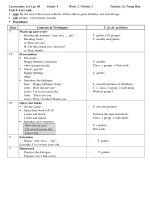LET’S TALK DEFENSE! TIPS, SKILLS, AND DRILLS FOR BETTER DEFENSIVE BASKETBALL pot
Bạn đang xem bản rút gọn của tài liệu. Xem và tải ngay bản đầy đủ của tài liệu tại đây (1.63 MB, 274 trang )
“I have known Herb Brown for many years, and his
coaching philosophies and principles are second to
none. Let’s Talk Defense! will show you the way to
establishing a superior defense, and it is a tool of the
trade that both aspiring and veteran coaches should not
be without.”
—John Calipari, Head Coach,
University of Memphis
“Herb Brown understands the most fundamental aspect
of the game and that is great defense wins champi-
onships. This book will explain the basic concepts of
how it is done.”
—Joe Dumars, General Manager
of the Detroit Pistons and
Six-Time NBA All-Star
“Defense has been a focal point for me throughout my
career. Working closely with Herb Brown this year gave
me an opportunity to work with a leading authority on
the subject. Let’s Talk Defense! captures the essence of
his deep-rooted understanding of the way defense
should be played, and I highly recommend it to coaches
and players of all ages.”
—Lindsey Hunter,
Ten-Year NBA Veteran
“Let’s Talk Defense! is a comprehensive compilation of
defensive schemes, concepts, and philosophies. It is the
product of the Brown brothers’ years of experience and
leaves no defensive stone unturned. Let’s Talk Defense!
is a must read for both players and coaches at all levels
of the game.”
—Isiah Thomas,
NBA Hall of Fame Player,
Former NBA Head Coach,
and Current President of
the New York Knicks
This page intentionally left blank.
DEFENSE!
LET’S TALK
TIPS, SKILLS, AND DRILLS FOR BETTER DEFENSIVE BASKETBALL
HERB BROWN
Copyright © 2005 by Herb Brown. All rights reserved. Manufactured in the United States of
America. Except as permitted under the United States Copyright Act of 1976, no part of this
publication may be reproduced or distributed in any form or by any means, or stored in a database
or retrieval system, without the prior written permission of the publisher.
0-07-146052-7
The material in this eBook also appears in the print version of this title: 0-07-144169-7.
All trademarks are trademarks of their respective owners. Rather than put a trademark symbol
after every occurrence of a trademarked name, we use names in an editorial fashion only, and to
the benefit of the trademark owner, with no intention of infringement of the trademark. Where
such designations appear in this book, they have been printed with initial caps. McGraw-Hill
eBooks are available at special quantity discounts to use as premiums and sales promotions, or for
use in corporate training programs. For more information, please contact George Hoare, Special
Sales, at or (212) 904-4069.
TERMS OF USE
This is a copyrighted work and The McGraw-Hill Companies, Inc. (“McGraw-Hill”) and its
licensors reserve all rights in and to the work. Use of this work is subject to these terms. Except
as permitted under the Copyright Act of 1976 and the right to store and retrieve one copy of the
work, you may not decompile, disassemble, reverse engineer, reproduce, modify, create
derivative works based upon, transmit, distribute, disseminate, sell, publish or sublicense the
work or any part of it without McGraw-Hill’s prior consent. You may use the work for your own
noncommercial and personal use; any other use of the work is strictly prohibited. Your right to
use the work may be terminated if you fail to comply with these terms.
THE WORK IS PROVIDED “AS IS.” McGRAW-HILL AND ITS LICENSORS MAKE NO
GUARANTEES OR WARRANTIES AS TO THE ACCURACY, ADEQUACY OR
COMPLETENESS OF OR RESULTS TO BE OBTAINED FROM USING THE WORK,
INCLUDING ANY INFORMATION THAT CAN BE ACCESSED THROUGH THE WORK
VIA HYPERLINK OR OTHERWISE, AND EXPRESSLY DISCLAIM ANY WARRANTY,
EXPRESS OR IMPLIED, INCLUDING BUT NOT LIMITED TO IMPLIED WARRANTIES
OF MERCHANTABILITY OR FITNESS FOR A PARTICULAR PURPOSE. McGraw-Hill and
its licensors do not warrant or guarantee that the functions contained in the work will meet your
requirements or that its operation will be uninterrupted or error free. Neither McGraw-Hill nor its
licensors shall be liable to you or anyone else for any inaccuracy, error or omission, regardless of
cause, in the work or for any damages resulting there from. McGraw-Hill has no responsibility
for the content of any information accessed through the work. Under no circumstances shall
McGraw-Hill and/or its licensors be liable for any indirect, incidental, special, punitive,
consequential or similar damages that result from the use of or inability to use the work, even if
any of them has been advised of the possibility of such damages. This limitation of liability shall
apply to any claim or cause whatsoever whether such claim or cause arises in contract, tort or
otherwise.
DOI: 10.1036/0071460527
Want to learn more?
We hope you enjoy this
McGraw-Hill eBook! If
you’d like more information about this book,
its author, or related books and websites,
please click here.
v
Contents
Foreword by Larry Brown, Head Coach, Detroit Pistons vii
Preface ix
Player Movement Legend x
Acknowledgments xi
11 Defensive Coaching Philosophy 1
12 Defensive Keys to Victory 17
13 Coaches’ Overview: Communication Between
Players, Assistant Coaches, and Staff 29
14 Defensive Checklist: Things to Teach and
Stress Every Day 41
15 Coaching Methods: Conducting Practices 51
16 Defensive Principles and Rebounding 77
17 Individual Defense,Team Defense, and Drills 87
18 Defending the Pick and Roll 111
19 Defending Specific Plays 129
10 Trapping and Double-Teaming 151
11 Transition Defense and Drills 167
12 Zone, Press, and Combination Defenses 175
13 Defending Special Situations 193
14 Scouting 203
For more information about this title, click here
vi
CONTENTS
15 Miscellaneous Drills 207
16 Summary 215
Appendix: Getting It Started: The Warm-Up
by Arnie Kander, Strength and Conditioning Coach/
Physical Therapist, Detroit Pistons 217
Glossary of Basketball Terms 233
Index 255
vii
Foreword
H
erb Brown has been almost everywhere basket-
ball is played. His coaching experiences have
taken him all over the world over the past 40-
something years. I know Herb has learned and tried to
take something positive and useful from every stop on
his coaching tour. The material for this book has been
compiled from many different sources. I don’t think you
will find many coaches more committed than Herb
Brown. He has always been a tireless worker with an
unparalleled appetite for basketball knowledge. The man
has dedicated a great deal of his life to the game of bas-
ketball and Let’s Talk Defense! is just one of the fruits of
his labor.
Herb and I have always believed defense to be the
great equalizer. Even if your team seems short on per-
sonnel when compared to that of your opponents, a solid
defense can effectively bridge the talent gap. Basketball
is a basic game; if you score more points than your oppo-
nent, you win the game; and if you stop the other team
from scoring points and play the right way, you can win
games even when your team struggles offensively.
I think this book will provide players and coaches at
all levels with a comprehensive and easy-to-understand
blueprint of how to build a successful defense. We used
many of these principles and techniques with the Detroit
Pistons in the 2003–2004 NBA championship season.
Success, defensive or otherwise, can only be achieved
through hard work and dedication. Teams must be
thoughtfully trained, drilled, and coached. Part of this
equation for defensive success can be found in the pages
that follow. The other parts of the equation will have to
come from you.
Copyright © 2005 by Herb Brown. Click here for terms of use.
viii
FOREWORD
I am proud of Herb’s professional and personal
achievements. This book is the product of his intellect,
diligence, and vast experience in teaching and coaching
the game of basketball. It’s a tool no coach should be
without.
—Larry Brown, Head Coach, Detroit Pistons
ix
Preface
D
efense is a state of mind. It is, in the opinion of
this author and many other coaches, the great
equalizer. Our philosophy has been developed
over a period of time and it is being constantly refined to
this day. This philosophy is not the only way to coach
and teach defense, but it may give you ideas you will
want to incorporate or think about adding to your own
defensive philosophy. We all seek information that can
help to broaden our horizons, and I hope some of these
methods and ideas will help or encourage you to innovate
and try different things.
Some of the material in this book may seem repeti-
tive, but the repetition has been by design. Defensive
mastery requires constant teaching, practice, and repeti-
tion. These elements cannot be overlooked if you want
your team to be successful. There is also some overlap
with certain tenets and principles appearing in sev-
eral sections of the book. This is necessary to give the
reader a complete view, in context, of each topic without
confusing references to other sections of the book.
Throughout there are pictures and more than 200 dia-
grams intended to help you visualize the movements and
players involved in the various drills discussed. You will
want to refer to the Player Movement Legend that fol-
lows as you study the diagrams.
It is my hope that this book whets your appetite and
provides food for thought as you consider the impor-
tance of defensive basketball.
Copyright © 2005 by Herb Brown. Click here for terms of use.
x
Player Movement Legend
DEFENSIVE PLAYER'S
MOVEMENT
PASS
OFFENSIVE PLAYER'S
CUT
SCREEN PICK
2ND CUT
2ND PASS
DRIBBLE
3RD PASS
DEFENSE
1 2 3 4 5
OFFENSE 12345
PLAYER WITH BALL
COACH WITH BALL
Copyright © 2005 by Herb Brown. Click here for terms of use.
xi
Acknowledgments
W
riting a book on defense has always been
on my agenda. I finally decided to put my
thoughts on paper while I was an assistant
coach with the Portland Trail Blazers during the 2002–
2003 NBA season. Working daily on the manuscript, I
was able to complete it while working as an assistant
with the 2004 NBA Champion Detroit Pistons. It is my
fondest desire that what follows will benefit the reader.
Many people deserve mention for encouraging and
prodding me to complete this project, and they deserve
special thanks. Without their assistance I might still be
writing. I cannot thank the people at McGraw-Hill
enough, especially my editor, Mark Weinstein, who
believed in the project when I first presented it to him,
worked diligently for its acceptance, and then continually
provided ideas and suggestions as well as made certain
that I met the necessary production deadlines. He has
been a valuable sounding board as has been Heidi Bres-
nahan, my project editor at McGraw-Hill.
Thanks to the Detroit Pistons organization and direc-
tors of media relations, Kevin Grigg and Paul Hickey, for
their editorial and photo acquisitions help. Thanks to
Judy Dowgiert, Nancy Bontumasi, and Missy Erwin for
manuscript and computer assistance. Thanks also go to
Melissa Carbonaro for formatting the manuscript a num-
ber of times. Special kudos to Chris Hiller of the Palace
Creative Group for his exceptional work on the book’s
diagrams.
I greatly appreciate the cooperation of the Detroit
Pistons management—Bill Davidson, Oscar Feldman, Joe
Dumars, and Larry Brown—and the finest group of
NBA players and staff I have ever worked with, all of
Copyright © 2005 by Herb Brown. Click here for terms of use.
xii
A CKNOWLEDGMENTS
whom bent over backwards to try to make this book
successful. The outstanding play-off performance of the
Detroit Pistons reflects what I believe defense and team-
work are all about.
My agent, Matthew Brown, was instrumental in
organizing and pulling everything together. He, along
with Ed Krinsky and Michael Holton, provided many
invaluable content and editorial suggestions.
I would like to thank all the coaches and players I
have ever been associated with for their contributions
as well as the many coaches and players who have
shared their basketball knowledge, thoughts, and insights
with me.
I’d also like to thank the players who played with me
and the coaches who assisted me in the 1997 and 2001
Maccabiah Games.
A very special thank-you to my wife, Sherri, for put-
ting up with my mood swings as I tried to meet my
deadlines.
1
1
Defensive Coaching
Philosophy
Copyright © 2005 by Herb Brown. Click here for terms of use.
2
LET’S TALK DEFENSE!
When a team is prepared and committed to playing
defense each time they hit the floor, that team has
an opportunity to win any game, especially if they
have dedicated themselves to stopping both the col-
lective opposition and their individual opponents.
Defense is a constant. It can help you win games even
when your team is having an off night offensively.
Defense is three-dimensional: it is desire, discipline,
and dedication.
Yo ur opponents may be more physically talented,
but if you can limit their ability to score and take
away the things they want to do you should be in a
position to win just about any game. You must begin
to teach and preach defense from the first moment
you meet with your team. Just as you cannot wait to
press until the end of a game when you are 20 points
behind, you must immediately emphasize the impor-
tance of defending as the strategy to win ball games.
Defense is not simply a last resort to get you back in
the game; it is the solid foundation of a winning pro-
gram. Defense requires discipline; if a coach is firm
initially, he will set the tone early and never have to
emphasize the importance of defense later on in the
season.
Many coaches, most notably Hall of Fame coach
Dean Smith, believe and have said, “Coaches are
hired to teach execution; they are not hired to teach
effort.” Effort is the primary prerequisite for play-
ing defense and basketball successfully. A defensive
mind-set, effort, determination, and execution must
be there every night in order to give your team a
chance to win when the ball is not going in the bas-
ket and your team is struggling to score. Defense can
change the tempo of the game and be disruptive. It
can be used to force opponents into playing and
executing against defensive schemes they have not
worked with and are uncomfortable playing against.
The aim of every great defensive team is to take
something away from their opponents. Our goals are
3
DEFENSIVE COACHING PHILOSOPHY
always to limit the opposition to one bad or ill-
advised shot and no offensive rebounds.
Defense wins championships. This is true for
most sports, not only basketball. Pat Summit, the
successful University of Tennessee Women’s Basket-
ball coach, believes that “Defense wins games but
rebounding wins championships.” I tend to agree
with her statement. However, our philosophy is still
the same: Defense wins championships. We consider
rebounding just one integral part of excellent defen-
sive basketball.
Many times the crowd will underestimate or fail
to recognize a team’s great defense, but people in the
know have nothing but admiration for these efforts.
To de velop a team’s defensive attitude coaches must
teach or preach defense from their team’s first meet-
ing or practice. The more frequently the players are
reminded of the importance of defense and the more
they practice and work at it, the more quickly they
will understand how necessary it is to the team’s
overall success.
Placing an emphasis on strong defensive aware-
ness and techniques is definitely not a deterrent to
teaching offense. On the contrary, I have always
thought it helps to make your team better offensively
at the same time. Your team will get to practice
against a defensive-minded opponent every day, and
your defense is also forced to execute against every
conceivable offensive maneuver they might face in a
game. This will quickly help to enhance your team’s
overall offensive execution as well as each player’s
offensive abilities and skills. It will also help you, the
coach, develop a multiple-offense philosophy. Face
it, players love to play offense and they are always
looking to improve their ability to score. Working
against an aggressive defense every time they practice
can only help the team’s offensive execution.
The shot clock has also helped teams both offen-
sively and defensively. The NBA, the minor leagues in
4
LET’S TALK DEFENSE!
the United States, and all of the international bas-
ketball leagues have adopted the 24-second shot
clock, and it is my belief that this speeds up the game
and makes players better and more skilled because
they have to do things at a more rapid pace. I think
colleges would benefit if they had the same shot
clock as other levels of basketball. I believe high
school and all other levels should continue to play
with longer shot-clock time constraints.
It has always been my belief that you build a
strong foundation first and then expand and develop
what you teach. With that in mind I am a proponent
of employing a varied defensive arsenal that includes
many different schemes designed to exploit and keep
opponents off balance. Today’s coaches and ath-
letes are so gifted that they are capable of scoring in
many different ways, and you must have an alternate
plan if one defensive scheme is unable to stop an
opponent.
There is no one correct way to play defense and
I will not pretend to present a defensive philosophy
or strategy that is in any way original. My plan of
action has evolved over participation in many bas-
ketball seasons. It has been and continues to be influ-
enced by a number of outstanding coaches as well
as by the changing nature of the game. In fact, I must
emphasize that I am continually learning from
coaches at all levels of the game. Many times when
a coach asks me why we do something, explaining
that he or she does it differently, it gives me pause
and causes me to rethink the situation, which either
reinforces or possibly refines my teaching of a par-
ticular defensive scheme.
My first taste of the importance of defense began
when my high school coach, Bob Gersten at Long
Beach High School in New York, emphasized man-
to-man defense in all our practices. I can still vividly
remember playing defense against a five-man weave,
sliding through when the player I was guarding
5
DEFENSIVE COACHING PHILOSOPHY
received the ball, and stepping back and letting my
teammate through when the player I was guarding
passed the ball to his teammate. I then continued to
pick up bits and pieces of defensive strategy by talk-
ing to other coaches, working at basketball camps,
attending basketball clinics, watching as many games
as was humanly possible, and reading everything
about basketball and defense that I could get my
hands on.
Studying the philosophy, teaching techniques,
practice, and game management of successful
coaches has also continued to help me form a defen-
sive system. I developed my first half-court defense
coaching system after I’d viewed a soft-drink com-
pany’s promotional film featuring Don Haskins and
his NCAA Championship Texas Western University
team. The film demonstrated the basics of their
defensive system. I later learned that this was the
foundation established by Haskins’s college mentor,
Mr. Henry Iba at Oklahoma State University. Iba’s
coaching and defensive philosophy have influenced
many of the most successful basketball coaches of all
time. He is the founder of one of the basic defensive
systems of the modern game.
Certainly a great deal of my knowledge and suc-
cess is due to the relationship I have had with my
brother, Larry Brown, one of America’s greatest
coaches. As we were growing up we shared many
thoughts about how basketball was and should be
played, and fortunately we still are able to do so
today. Having the opportunity to coach with him at
the NBA level has also been a tremendous coaching
experience in that we learn, perfect, and adjust our
defensive techniques every day. He is a great student
of the game and he constantly searches for ways to
improve his team’s defense.
Larry and I first learned about teaching and
coaching from our high school football coach, Roy
Ilowit, who brought us to camps in Maine and Penn-
6
LET’S TALK DEFENSE!
sylvania, hired us as counselors, and had us teach
basketball as well as other sports every day. He
constantly tutored us by requiring that we teach fun-
damentals to our campers. The teaching of funda-
mentals on an everyday basis may now be a lost art,
but it has always served us well.
I fondly remember the first book I ever read
about basketball. It was a pocket book on basketball
fundamentals written by Arnold “Red” Auerbach,
the legendary former coach of the Boston Celtics.
The book explained the basics of dribbling, passing,
and ball handling; it stressed the right way to play the
game. The book still occupies a prominent place on
my desk. Red was my first coaching idol, and he
remains a great influence on my career (even though
I am not a cigar smoker).
There is more than one way to get the job done.
So much depends on the type of team you are coach-
ing and each player’s unique abilities. You must get
your players to understand that to play outstanding
defense they must talk and communicate with each
other on the court. Our defensive philosophy is based
on our defense always taking something away from
the offense. We always want to negate our oppo-
nent’s strengths—and to expose and exploit their
weaknesses.
As previously mentioned, you as a coach must
establish rules for teaching defense, both for the team
and for individual players. We think you should
always emphasize putting pressure on the ball and
having your hands up and active to contest all shots
and passes. Different rules should be implemented
depending on whether the dribble is alive or has been
used up. If you believe in shrinking and clogging the
middle and keeping it compact without applying
extreme ball pressure, make sure you thoroughly
explain and teach your system.
My brother’s coaching credo, one I thoroughly
embrace, demands that his players always respect the
game and “play the right way.” He requires his play-
7
DEFENSIVE COACHING PHILOSOPHY
ers to defend, rebound, run the floor, block shots,
and constantly share the ball. He believes that every-
thing else will take care of itself if his team con-
centrates on these fundamentals. We believe very
strongly in these concepts and try to re-emphasize
them whenever we address the team.
Different Coaching
Philosophies
Great defense generates easy transition scoring
opportunities and this makes the game fun. When
discussing his basketball philosophy John Calipari,
the highly successful University of Memphis coach,
mentions that he wants his team to play aggressively
and that he expects his team to commit at least 12 or
13 turnovers each game. However, he also wants his
team to play aggressive defense by forcing oppo-
nents to have even more turnovers than his team.
Turnovers are similar to poor shots in that they pro-
vide you with one less opportunity to score, but Cali-
pari also wants to take at least 10 more shots than
his opposition. He promotes aggressiveness. He
doesn’t want his players to play tentatively or scared
on either end of the floor.
I’ve heard coaches talking about their offense.
They mention how important it is to have their best
player or players take the most shots. I believe this
points out the importance of having your defense
prepared to stop your opponent’s key players by
keeping the ball away from them as much as possi-
ble. Great offensive players instinctively know how
to get the ball when they need to have it in their
hands. Therefore it is crucial that good defensive
teams work at denying great players the ball and lim-
iting their touches.
A coach’s defensive philosophy should be
reflected in his or her defensive strategy and tactics.
8
LET’S TALK DEFENSE!
Ours includes a preference, many times, for using
some form of a full-court press after all made shots
(field goals and free throws), following time-outs,
after dead balls, and to begin quarters or halves. We
feel it is easier to set up and/or change your defense
in these situations. It also helps to eliminate confu-
sion and indecision. I know a number of coaches who
are not reluctant to go against the norm and change
defenses on the fly in an attempt to unsettle their
opponents. However, we don’t feel that tactic meets
our needs because we want each of our players to
know what defense we are playing.
Goals of Our Defensive
Philosophy
The primary goals of our defense are to always
extend and pressure up the court to force the drib-
bler to turn and change direction, to body up and
guard all cutters whether they be straight basket or
weak-side cuts, to body up and go over weak-side
flares, and to pressure the ball to prevent the skip
passes, which help our opponents post the ball when
we are fronting the post.
Another of our primary goals is to have our play-
ers always strive to make each other better. We must
develop trust. We don’t only require our big men to
provide weak-side help defensively; we also require
our guards and perimeter players to help on the weak
side. When your team has shot blockers and great
anticipators like Detroit’s Ben Wallace and Rasheed
Wallace, teammates have a tendency to try to steal
the ball because they know Ben and Rasheed are
back there to clean things up.
We do not encourage taking the easy way out, a
mentality that we feel exemplifies losing basketball.
Defense equals five men working together to stop an
opponent.
9
DEFENSIVE COACHING PHILOSOPHY
Demands of Our Defensive
Philosophy
Yo ur defensive philosophy should be reflected by
your defensive system and the way you teach your
team to play. The following is a list of specific
requirements our defensive philosophy demands.
1. We require our players to play 94 feet of
defense after all made shots if at all possi-
ble. Many times, however, we might also
decide to change tactics and pressure and
pick up at three-quarter or half-court
instead as an alternate means of disrupting
and keeping the offense off balance. We try
to use anything that effectively changes the
tempo and thereby causes our opponents to
be indecisive. We might substitute two
aggressive on-the-ball defenders to pres-
sure up and change the game’s tempo or
change defenses whenever we feel it is
necessary.
2. We emphasize playing great transition
defense after all misses, steals, defensive
rebounds, and turnovers. The first man
back on defense protects the goal and his
teammates hustle back and get level with
the ball. We may retreat, looking for deflec-
tions, but we don’t stop running to get level
with or below the ball.
3. In defensive transition we continually
emphasize the need to protect the goal,
quickly change ends, locate and stop the
ball, and get all defenders level with the
ball. We discourage reaching or flailing at
the ball in transition, a characteristic we
believe fosters losing basketball.
4. Defenders should always exert maximum
ball pressure and make all passers drivers if
the dribble has not been used.
10
LET’S TALK DEFENSE!
★ We encourage aggressive on-the-ball de-
fense. Our objective is to control our op-
ponents by stopping dribble penetration
and a straight line drive to the basket.
★ Our players are taught to get their bodies
up and into the passing lanes. We also
make it a point to front or three-quarter
all post players depending on the position
of the ball and where the player is posting
up on the court. We teach playing one half
a man, bodying up and staying connected
on drop isolations to prevent the spin lob.
We must be aware of ball location and
our opponent’s position when deciding
whether or not to front the post. When we
front we want to bend down and sit on the
offensive player’s legs to deny him the ball
and the easy high-low pass. We also want
to body up and deny low post position,
and try pushing the offensive player off
and away from the low block.
★ We challenge and contest all shots. We
always want our players to have a hand up
to distract the shooter. We don’t want to
come forward and out of control when we
close out. We prefer to give up a contested
jump shot rather than a drive. Knowing
the opposition’s personnel helps you know
the shooters you must challenge and stop
and the shooters you want to allow
perimeter shots. We close out long or short
depending on the shooter’s ability.
★ We always emphasize blocking out. We
stress keeping our opponents off of the
glass and try to limit second-shot oppor-
tunities. Our players learn to find the ball
before they leave their feet to rebound.
Effective defensive rebounding requires all
five defensive players. Long shots equal
long rebounds.
11
DEFENSIVE COACHING PHILOSOPHY
5. We want to establish and execute great help
and support defense: we shadow, dig, and
give full-bodied help; stop (prevent and
limit) all penetration; and we shrink the
court and pack the paint.
6. We orchestrate and develop weak-side rota-
tion and help schemes (NBA Shadow or Tilt
defensive principles), and we constantly
emphasize the importance of not permitting
our help to get beat.
★ We limit ball reversal, and we want to
channel and/or influence the direction of
the ball.
★ We decide whether we want to force the
ball sideline or channel it toward the mid-
dle, and our decision may depend on
whether or not we are blessed with shot-
blocking presence.
7. We constantly stress the importance of
defensive rebounding and try not to permit
second shots.
★ Our players box out, pinch outstanding
rebounders, and box the shooter on all
free throws, and we require all five defend-
ers to box out and look to rebound on
every defensive possession.
★ We teach our players to tip out rebounds
they cannot control by designating an
area, possibly the corners, where we might
want to tip the ball. Our players are then
aware of where to expect the ball to be
tipped. It’s not a good idea to tip the ball
long and start an opponent’s fast break
8. We’ve developed half- and full-court zone
and combination, man-to-man, match-up,
or hybrid defenses. We feel you should have
full-, three-quarter-, and half-court presses
in your arsenal, each defense utilizing the









